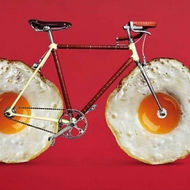Buycycle
An app concept that divides groceries between family members so that it is possible to do the grocery shopping by bike - making shopping for family dinners possible even without a car.

This was a group project with the aim of merging two random themes together into an app concept - cyclists and family dinners.
The project was part of the Interaction Design Methodology course at Chalmers which included the application of several different user centered methodologies that would help us understanding our users, their problems and requirements and the domain at hand.
*Final mockup visualized by a team member
The project brief
The aim of the project was to learn how to approach a very open design task with a brief only containing a scenario and an intended user, to adapt a suitable design process and utilize appropriate design methods in the iterative stages of the design process. The topics we were assigned to combined were randomized by the course lecturers - giving us the difficult task to design for:
+
=
SCENARIO

Family dinner
USER

Cyclists
PRODUCT
?
A smartphone app
HOW do we design for this??
That was our very first thought when we were assigned our two topics, Family dinner and Cyclists. They are definitely not the two most closely related topics and initially, we had no idea how to approach the domain.
Design process







We utilized an iterative user-centered approach in order to investigate what issues may exist in shopping for family dinners and if these could be addressed by designing a new app and utilizing bikes.
PRE-STUDY (1)
As part of our pre-study, we did simple online searches to see if there were already connections between our two topics. We did not find much.
Eventually, thanks to ideas found in the pre-study, ideation methods such as creative toolkit, skewing, brainstorming and image boarding, we were able to come up with a few ideas.

Our focus became...
... to design an app that would encourage and help people to use their bikes when going grocery shopping.
USER STUDIES (2)
To gather insights about how families do their grocery shopping today, we conducted a field observation at a supermarket and published a survey where we asked people about their shopping and biking habits.
Field study
We found that although there were many spots for people to park their bike, most people came to the store by car. Those who came by bike bought only a few items, probably since a majority of the bikes did not have enough room for storing the groceries.

Questionnaire
To reach a wider target audience, we also did an online survey (receiving 116 answers) asking people about how they shop for groceries and how they bike. 70% said that they have access to a bike - still, 75% said they never bike to the supermarket but use the car. We also found that it is often only one person in the family who handles all the shopping.
Do you have access to a bike?

How often do you bike to the supermarket?

ANALYSIS (3)
As part of our analysis, we looked closer at all our findings to see if there were patterns to be seen or problems to address. After using the KJ method and affinity diagram, we could determine a few key functinoalities the app would need to hold.

Problems identified
• Taking the car makes people sedentary and harms the environment
• It is hard to bring all groceries on one bike
• Normally, only one person handles the shopping for family dinners
App functionalities
• Plan dinner (Invite people, add date/location)
• Add groceries to shopping list
• Access family profile
• Alter bike properties (Carrying capacity)
• Divide groceries between invited family members
• Display route to closes supermarket
IDEATION (4)
Our ideation phase consisted of sketching and brainstorming on the main functionalities and how these could be implemented into the form of a smartphone app.

I also compiled a moodboard to guide the visual work and the feeling that we were aiming for with the app.

LOW-FI PROTOTYPE (5)
To test the layout and main functionality of the app, we did a simple clickable prototype based on wireframes. Testing the prototype on an actual smartphone helped us quickly grasp what aspects worked and what needed to be changed.



HIGH-FI PROTOTYPE (6)
To visualize the iterated design and test how it worked in the end, we created a clickable high-fidelity prototype as can be seen below.

The app provides an overview of all dinners the user has created or been invited to, when and where they are to take place and who else is invited.
A map will show the user their relative location to the closest supermarket and how to get from there to the dinner.
Each guest can see in their task list what they are to buy for the dinner - which has been automatically divided based on each person's bike's capacity.
All in all...
The Buycycle app makes it easier for families to plan their dinners together as the groceries are split automatically depending on the capacity of the bikes and the availability of the guests - allowing for the car to be left at home in favor for a more
.png)















